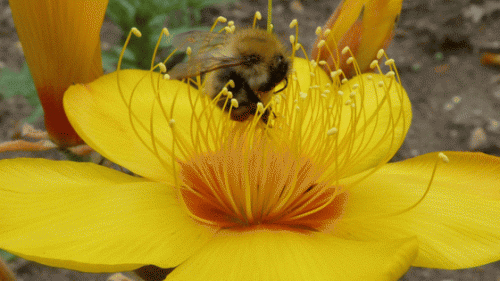How flowers use a touch of bling to woo the bees

(PhysOrg.com) -- Beetles use it, birds use it. Plants use it too. Iridescence is the shimmery colour effect that makes things eye-catching.
Tilt a CD in your hands and you will see it change through all the colours of the rainbow. CDs are clear plastic: they appear brightly coloured because the tiny data grooves on their surface reflect different wavelengths of light at different angles. This type of colour is called structural colour to distinguish it from pigment colour, colour created by chemicals that absorb light.
At Science Live, the Royal Society Summer Science Exhibition in London this week, a team of researchers from the University of Cambridge will present some of the latest research into structural colours in flowers. This phenomenon was only identified in 2009 when hibiscus flowers were shown to use the same trick as CDs. Plant scientists have collaborated with physicists to create a series of interactive displays. How nature dresses to impress explores the science of colour in plants, and shows in particular how some flowers use structural colour to give them the edge in attracting pollinators.
Plants use animals, such as bees, to carry pollen from one flower to another so that fertilisation can take place. To attract pollinators, flowers offer a reward such as sugary nectar. The bright colours of flowers act as adverts, making them visible against a green background. Structural colour can be very intense, and makes flowers even more vivid and irresistible to pollinators. Visitors to Science Live will be able to watch a colony of live bumble bees explore different objects, and observe how they select between varying colour effects.
It used to be thought that plants with structural colours were exotic rarities. But some of our best-known garden flowers, such as tulips, are now known to have them. They use nanostructures – surface grooves or layers of different materials – that cause interference and allow some colours of light to be reflected while others pass through the flower. Only some of the colours produced by these nanostructures are visible to the human eye, which explains why scientists have only just begun to investigate them: until quite recently they were simply not known to exist.
Presenting their research to the public in the highly interactive environment of Science Live will be plant scientists from the University of Cambridge led by Dr Beverley Glover, who heads the Evolution and Development lab in the Department of Plant Sciences. She and her team have worked with Professors Ulli Steiner and Jeremy Baumberg from the Nanophotonics Centre at the Cavendish Laboratory, the University of Cambridge’s Physics Department, to illustrate the interaction between flower colours and the physics of light.
Dr Glover said: “We’re really keen to show the public, and school students in particular, how biology and physics interact and how exciting it is to explore the ways that plants and animals play tricks with the light.”
The exhibit also includes collaborative work from Professor Pete Vukusic from the University of Exeter and Dr Lucas Joppa from Microsoft Research Cambridge.
Visitors to Science Live will be able to test their skills in a specially-devised “Nanoblocks” game which will allow them to design their own nanostructure and see what colours it would produce to the human eye and to a bee’s eye. Every hour, one of the Cambridge University scientists taking part in the exhibition will perform an “interference dance” with bubbles – devised to show how interactions between different wavelengths of light can result in spectacular colours. Dr Glover says: “We hope that people will find this a fun way of learning about the physics of colour – I certainly enjoy watching my physicist colleagues dancing!”
More information: royalsociety.org/summer-science/2011/
Provided by University of Cambridge




















